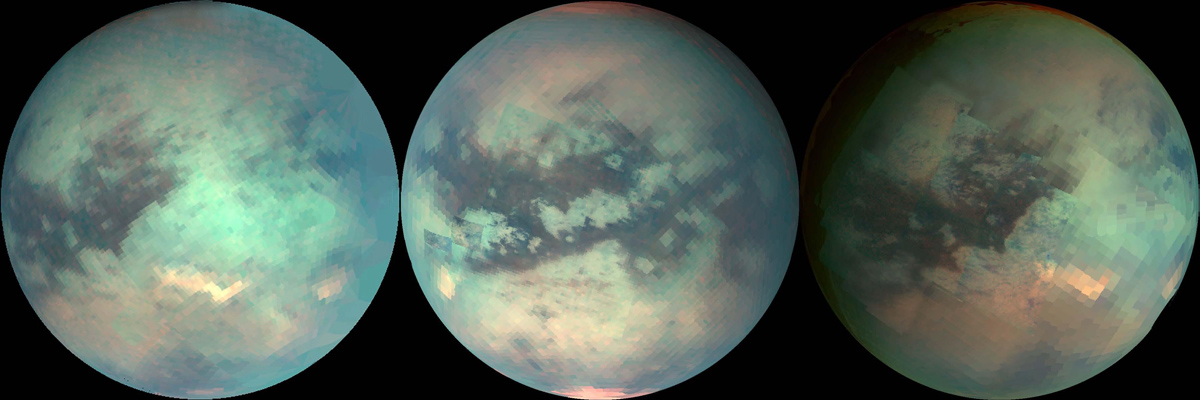Article #006: Life on Titan
Published: 01/11/2023

Image of Titan's surface under its dense atmosphere from all uncovered angles (Image Credit: NASA/JPL-UOA)
Titan, Saturn's largest moon, is an icy moon completely engulfed within a golden colored atmosphere. This moon has strong evidence that thriving life is a possibility on this moon. In this article, we will uncover more details and information about the Moon Titan and see whether life is really sustainable on Titan and if we can live there.
Details
Titan is the second-largest moon discovered in our solar system leaving Ganymede (Jupiter's largest moon) as the only larger moon. Titan is even larger than the Planet Mercury itself.
Titan has a radius of about 1,600 miles and orbits 759,000 miles from Saturn. Light takes 80 minutes to reach Titan and since the distance between the Sun and the moon itself is very large, the sunlight is very dim on Titan.
Titan takes 15 Earth days and 22 Earth hours to complete a full orbit of Saturn. Compare to Earth's moon (~30 days to orbit Earth), Titan orbits very fast. Titan is also tidally locked in synchronous rotation with Saturn just like Earth's moon.
Titan's internal structure is completely known yet, but a model from the Cassini-Huygens mission suggests that Titan has five primary layers with a water-bearing silicate rock core (about 2,500 miles in diameter).
Life on Titan
Titan is the only moon in the solar system with a dense atmosphere, and it's the only celestial body with rivers, lakes, and seas on its surface. Similar to Earth, Titan's atmosphere is primarily Nitrogen and a small amount of Methane. This provides strong evidence of life being sustainable on Titan. Titan is also the only other world except Earth where standard precipitation cycles occur with raining clouds flowing across the surface. Astronomers haven't been able to uncover what is underneath the dense atmosphere, but they have reason to believe that Titan has a subsurface ocean of water.
The surface of Titan is one of hte most Earth-like places in the solar system. Titan also has volcanic activity, however, instead of spewing hot molten rock,
it spews out liquid water "lava" from the ocean subsurface that the core is surrounded by. Titan's surface is also covered by flowing liquid methane
oceans and lakes.
Titan's surface also has large desserts with dark dunes of hydrocarbon grains. The surface also has a few visible impact craters, showing astronomers that
the surface is actually relatively young compared to Earth. Astronomers also believe that titan's surface also feels tectonic forces just like our planet
Earth does. These tectonic plates can cause huge ground-quakes and result in tsunamis of liquid methane.
The Cassini spacecraft's numerous gravity measurements of Titan revealed that the moon is hiding an underground ocean of liquid water under Titan's surface. The European Space Agency has probes (Huygens probe) that also measured radio signals during its descent to the surface of Titan, in 2005. The signals showed signs of the presence of an ocean 30-50 miles below the surface. The discovery of global ocean of liquid water adds Titan to the handful of worlds in our solar system that could potentially harbor life with its habitable environments. Titan's rivers and lakes of liquid methane could also harbor life, however, it would be very different from life as we know it. Titan has the potential to harbor life similar to our kind (subsurface oceans of liquid water) and distinct variations of life that we have yet to discover (surface rivers, lakes and other bodies of flowing liquids).
As of February 2023, evidence of life on Titan has yet to be discovered.
Can we survive on Titan?
Simply put, the answer is NO.
Titan reaches temperatures of upto -290 degrees Fahrenheit which is unsuitable for human life. Even though the surface of Titan is extremely similar to Earth, Titan is after all, still a moon. Humans would have to get used to a completely new Calendar and time system. Week-long eclipses would occur every other week, and because of the tidally locked rotation, only one side of Titan will receive sunlight for seven year-long seasons. Very little sunlight actually reaches Titan and since sunlight is essential for all life on Earth, it is not possible for us to thrive with minimal sunlight.
Research Advancements and Hypotheses
To observe Titan from its surface and within its subsurface and search for the building blocks of life, NASA has started the Dragonfly mission which will create drones that will fly across the surface and subsurface to examine sites on the moon. Dragonfly will launch in 2026 and is expected to arrive in 2034.
Titan is an analog to the very early Earth, and can provide clues to how life may have started on our planet. Even though Titan is relatively very young, its subsurface is filled with oceans of liquid water. This could mean early sea creatures of the Planet Earth may be able to thrive and survive on Moon Titan. Possibly, life in Titan's subsurface could have evolved into common deep sea animals on Planet Earth such as Anglerfish. They may have even evolved far enough to form an under-water civilization that could be as advanced as our human civilization. Normal sea creatures like fishes and dolphins wouldn't be able to survive in the oceans of Titan because of the lack of sunlight in the subsurface. Since Titan's inner layers are mostly liquid water, Earth-like deep sea creatures may have survived. Since Titan looks like an icier version of Old Earth, we may be able to explore what our extinct deep sea creatures looked like. Maybe there's a key factor allowing them to thrive on Titan rather than Earth.

Image of drone models of NASA's Dragonfly mission hovering through Titan's surface (Image Credit: NASA/JHU-APL)
Written by BooleanCube :]